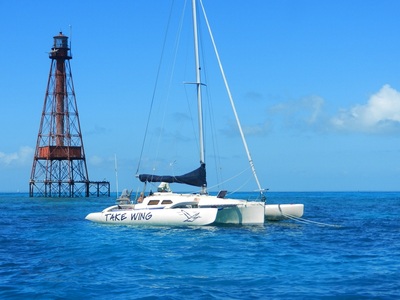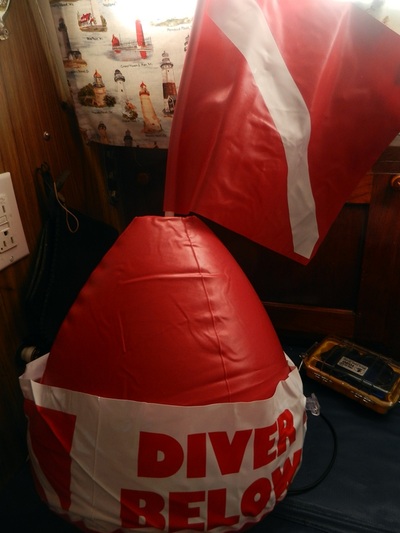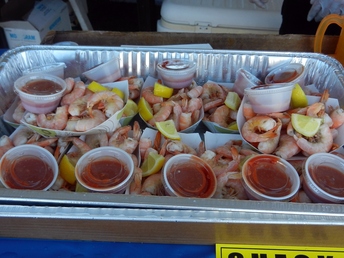 Shrimp awaiting customers at the seafood festival
Shrimp awaiting customers at the seafood festival March is the peak of the winter season in Marathon, with more boats in the harbor and more activities on shore than probably any other time of the year. Needless to say, we were in the thick of many of the activities. That left less time for boat projects, but we managed to squeeze a few in -- some more urgent than others.
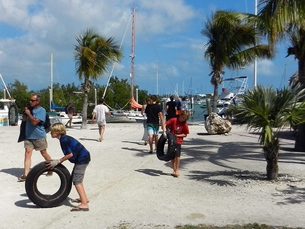 Harbor Clean-up Day
Harbor Clean-up Day Cleaning Up
There is a lot of junk that ends up in the water in any harbor. We saw that on our clean-up day back in the Hampton River. However, we had our first opportunity to participate in a clean-up day here in Boot Key Harbor on the first Saturday of March. It was a dinghy clean-up and we were assigned an area west of the harbor, along Boot Key, where the mangroves are thick and greedily hoard all the debris that the prevailing east winds will send them. We motored toward the outer edge of our territory where Sisters Creek begins. Before we made it all the way there we found our first prize: some ice bags and beer boxes from a small mangrove island at the edge of the harbor.
There is a lot of junk that ends up in the water in any harbor. We saw that on our clean-up day back in the Hampton River. However, we had our first opportunity to participate in a clean-up day here in Boot Key Harbor on the first Saturday of March. It was a dinghy clean-up and we were assigned an area west of the harbor, along Boot Key, where the mangroves are thick and greedily hoard all the debris that the prevailing east winds will send them. We motored toward the outer edge of our territory where Sisters Creek begins. Before we made it all the way there we found our first prize: some ice bags and beer boxes from a small mangrove island at the edge of the harbor.
 Dave in the mangroves: gotta get that garbage can
Dave in the mangroves: gotta get that garbage can As we made our way into the mangroves, the shallows forced us to abandon the motor for the oars and we made our way cautiously into the brambles. It quickly became obvious that the boat hooks would not retrieve this stuff from the dinghy. One of us would have to get out and get dirty. Cathy was first, retrieving a five gallon bucket of some liquid, a plastic crate, several bags, more beer boxes, etc. But Dave couldn't be left out. When we saw the distant 30-gallon garbage can in a seemingly impassable section of mangroves, he was there. After some frustrating slips of the boat hook, he managed to maneuver it to the dinghy and we carted to our "buy boat", a larger inflatable with a center console that couldn't do the shallow stuff. They collected from us and others and took it to the "mother ship" -- a larger fishing boat run by no other than Paul Lebo, the coordinator for the food booth volunteers at the Seafood Festival.
 One of several larger items hauled from the harbor.
One of several larger items hauled from the harbor. We continued to look for and find some amazing things, the most unusual and definitely the most difficult to retrieve was a large wooden, sandbox-like structure. It was heavy on its own, but had filled with sand and water, which we couldn't unload. So we dragged it like a sea anchor, with Dave holding on to it from the bow and Cathy trying to row the boat against it. As we made inches of progress out of the mangroves, our "buy boat" made its way closer and we met in the middle. Now they were weighted down so much that they couldn't make good progress. The other "mother ship" from the City Marina had to work its way over to them to retrieve the heavy stuff. Holly, on her kayak, came over to run a line between the two boats and help the marina boat load the trash. Of course, she first had to unload the TV that she had collected (on her kayak?).

At any rate, by the days end, we and our fellow garbage men had filled a dumpster to overflowing, and a garbage barge (a derelict boat that we filled with garbage). It was amazing, gratifying, but disturbing at the same time. After scrubbing the dinghy clean of mangrove bits, muck and slime, we joined the others for a picnic and swapped stories of our finds. There was also a competition of sorts, using an app called Goose Chase to run a scavenger hunt. To participate, you had to take pictures of your team before and after, and of some specific kinds of garbage you found. One item that scored points was a TV. Although 6 were actually found during the clean-up (including Holly's), let's just say our TV was found a little after the clean-up. I think they disqualified the points for it.
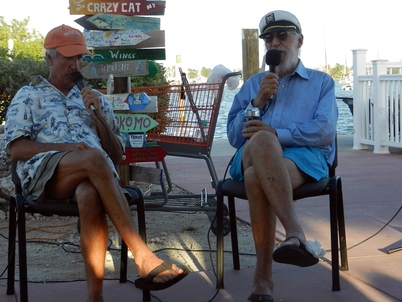 Miami and Captain Jack
Miami and Captain Jack Tall Tales
After the success of February's Storytelling get-together, we helped organize a second one. Dave regaled the crowd with his story of how we started out with little experience, yet managed to get insurance on our 36ft boat. One of the more moving stories was one Miami told about his family's 3-day search for their dog, Goose, who had become lost on an uninhabited island off the coast of Georgia. (You can read this story on Yume's blog through this link. )
Boaters, like most people, love to tell stories and some of us have more to tell than others. Captain Jack is one of those. At 93, he's been on boats for much of his life, currently living aboard his 28ft sailboat, Fantasea, at the marina. Along with Miami and Shelly, we helped organize a night to hear Jack's stories. Miami brought his sound system ashore and (after some food, of course) interviewed Captain Jack about his life and adventures. Captain Jack quickly got into it, taking us from a high rise in Chicago, to a farm in Indiana, to a boiler room in an Army ship in the South Pacific, to St. Petersburg, where he bought his first sailboat, and finally to southeast FL and Marathon. And it was fun taking the journey with him.
After the success of February's Storytelling get-together, we helped organize a second one. Dave regaled the crowd with his story of how we started out with little experience, yet managed to get insurance on our 36ft boat. One of the more moving stories was one Miami told about his family's 3-day search for their dog, Goose, who had become lost on an uninhabited island off the coast of Georgia. (You can read this story on Yume's blog through this link. )
Boaters, like most people, love to tell stories and some of us have more to tell than others. Captain Jack is one of those. At 93, he's been on boats for much of his life, currently living aboard his 28ft sailboat, Fantasea, at the marina. Along with Miami and Shelly, we helped organize a night to hear Jack's stories. Miami brought his sound system ashore and (after some food, of course) interviewed Captain Jack about his life and adventures. Captain Jack quickly got into it, taking us from a high rise in Chicago, to a farm in Indiana, to a boiler room in an Army ship in the South Pacific, to St. Petersburg, where he bought his first sailboat, and finally to southeast FL and Marathon. And it was fun taking the journey with him.
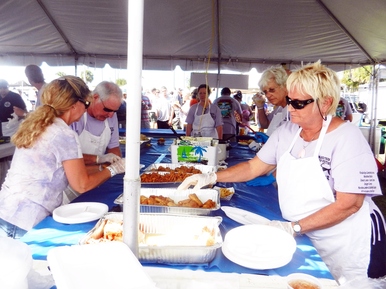 Serving up fish and lobster for the festival
Serving up fish and lobster for the festival And Then There's Seafood
Dave started making announcements for volunteers on the morning Net in late February. Since the volunteers would call the Chamber of Commerce directly, we never knew how effective the recruiting efforts were. However, as the time for the festival arrived, we were about to find out. Due to a turnover in the Chamber's staff only a couple of weeks before the festival, Dave decided we needed to step in to help.
The Chamber of Commerce is 5 miles away from the marina, a distance too far for most boaters, since most have no car. Dave had offered to deliver the T-shirts, which are the entry ticket for the volunteers, to the boaters in the harbor. All they had to do was give the Chamber their location in the harbor. With the change in staff, this information was not being collected. So, we announced on the net that anyone who had volunteered contact us. Wow! We had over 50 people on 30 boats. It took us most of an afternoon to deliver all the shirts, but by the day before the festival started, they were all in the volunteers' hands.
Dave started making announcements for volunteers on the morning Net in late February. Since the volunteers would call the Chamber of Commerce directly, we never knew how effective the recruiting efforts were. However, as the time for the festival arrived, we were about to find out. Due to a turnover in the Chamber's staff only a couple of weeks before the festival, Dave decided we needed to step in to help.
The Chamber of Commerce is 5 miles away from the marina, a distance too far for most boaters, since most have no car. Dave had offered to deliver the T-shirts, which are the entry ticket for the volunteers, to the boaters in the harbor. All they had to do was give the Chamber their location in the harbor. With the change in staff, this information was not being collected. So, we announced on the net that anyone who had volunteered contact us. Wow! We had over 50 people on 30 boats. It took us most of an afternoon to deliver all the shirts, but by the day before the festival started, they were all in the volunteers' hands.
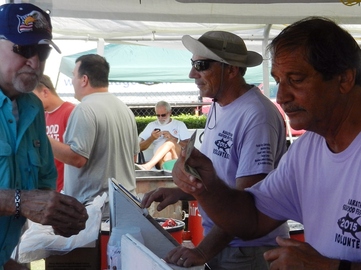 Taking the money
Taking the money We also started our working early, when we showed up Friday night and helped with some of the set-up activities for Paul and the food booth. We worked until after dark and then promised to be back the next day. Unlike previous years, we were needed most up front at the cash registers and serving food. Thousands of dollars passed through our hands over the two days. (And yes, it all made it into the till.) We don't know how much they made, but it had to be a good year. On Monday, Dave returned to help Paul break down the tents, harvest the oil for the Bio-diesel firm to pick up and clean the fryers. It sounds like a lot of work, but we wouldn't do it each year, if we weren't enjoying ourselves as well. And we did enjoy the food, of course.
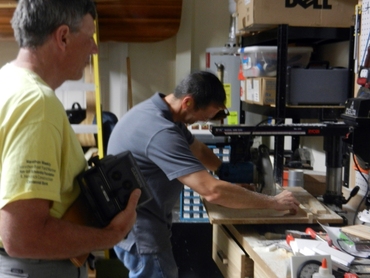 Dave and Dave creating new instrument mount
Dave and Dave creating new instrument mount Boat Stuff
New Chartplotter mount
Over the holidays, they had worked on it for hours. Dave and his brother-in-law (also a Dave) were tackling the problem of how to redesign our chartplotter mount to accommodate the new tachometer. Brother-in-law Dave had a workshop full of power tools, the skills to use them, and an engineering background for solving these problems. So, it wasn't surprising that in the process of adding the tach, they had worked out an ingenious system to remove the klunky clamps that had held the chartplotter in place while underway. (You had to make sure you ducked low when going down the companionway stairs.) Once in Marathon, we were ready to put the solution in place.
New Chartplotter mount
Over the holidays, they had worked on it for hours. Dave and his brother-in-law (also a Dave) were tackling the problem of how to redesign our chartplotter mount to accommodate the new tachometer. Brother-in-law Dave had a workshop full of power tools, the skills to use them, and an engineering background for solving these problems. So, it wasn't surprising that in the process of adding the tach, they had worked out an ingenious system to remove the klunky clamps that had held the chartplotter in place while underway. (You had to make sure you ducked low when going down the companionway stairs.) Once in Marathon, we were ready to put the solution in place.
 Old and new chartplotter mounts
Old and new chartplotter mounts We replaced the base of the chartplotter, which was a varnished piece of wood, with a piece of starboard. The tach would be mounted in a custom-made starboard box beside the chartplotter, secured to the same starboard base. To secure the base to the top of the companionway, the key was to devise a solution that would not require any holes being drilled in the companionway hatch. To do this, 2 small strips of starboard would be permanently attached with VHB (Very High Bond) double-sided tape. These would lock the mounting board in place. With the help of a sliding lock on the starboard side of the mount (the ingenious part of the design), we could easily remove the unit containing the chartplotter and tach and store them below.
 The base locks in place under 2 strips of starboard
The base locks in place under 2 strips of starboard When doing an initial fitting, Dave discovered the base and its locking strips were just a little too wide. After a bit of filing, the fit was perfect. Once we decided on a location, we marked the location of the locking strips on the companionway hatch. We cleaned both surfaces with alcohol, applied the tape to the blocks of wood and then secured them to the hatch. It was then just a matter of putting the slide onto the base, inserting it into its place between the 2 blocks and voila`, the instruments were locked in place. It's almost too easy now.

Sewing Work
"Cathy on Orion Jr can do canvas work". Cathy was looking at the VHF radio during the morning net, wondering if she had just heard right. Someone was looking to get some repairs done and the local canvasmaker wasn't available for a few days. Our friends on Natalie had just volunteered our services. Ummm. At any rate, Cathy was at work again. This time she was repairing tears in enclosure panels and cushions. It was a full day's work, but the customer seemed to be happy in the end. She had the use of her sewing machine for a few projects for us as well, making a cover for the trailer winch and new shades to completely surround the cockpit. This will help if we need to take showers there to give us some privacy.
"Cathy on Orion Jr can do canvas work". Cathy was looking at the VHF radio during the morning net, wondering if she had just heard right. Someone was looking to get some repairs done and the local canvasmaker wasn't available for a few days. Our friends on Natalie had just volunteered our services. Ummm. At any rate, Cathy was at work again. This time she was repairing tears in enclosure panels and cushions. It was a full day's work, but the customer seemed to be happy in the end. She had the use of her sewing machine for a few projects for us as well, making a cover for the trailer winch and new shades to completely surround the cockpit. This will help if we need to take showers there to give us some privacy.
 Under Sail to Sombrero Reef
Under Sail to Sombrero Reef Parting Shots
We headed out for a day sail and ended up snorkeling out at Sombrero Reef. We sailed most of the way there and back on a beautiful day. Cathy got to use her new Dive float for the first time, which let her wander farther from the boat.
We headed out for a day sail and ended up snorkeling out at Sombrero Reef. We sailed most of the way there and back on a beautiful day. Cathy got to use her new Dive float for the first time, which let her wander farther from the boat.


